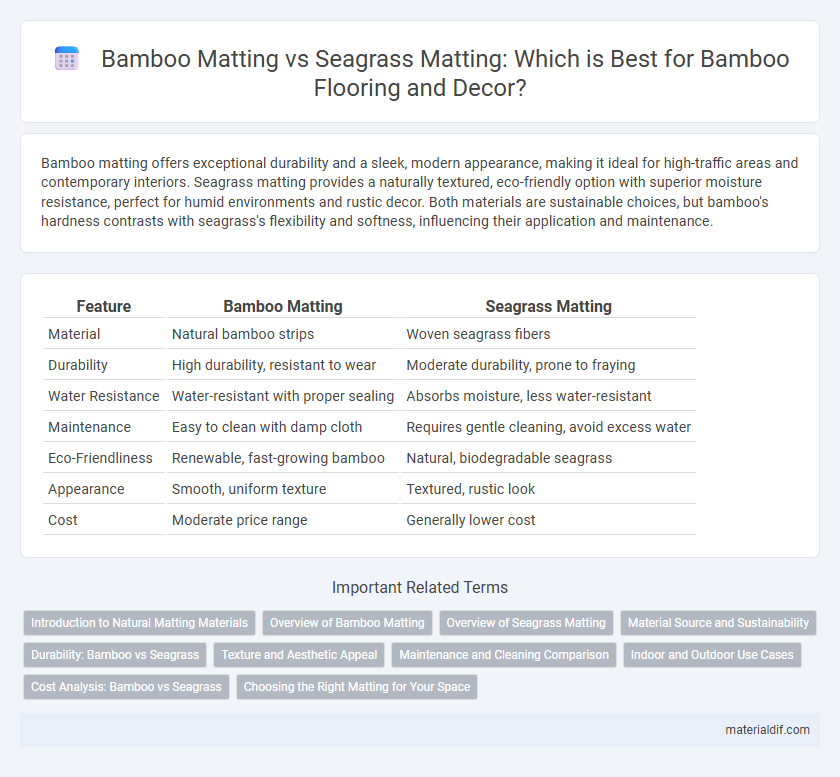Bamboo matting offers exceptional durability and a sleek, modern appearance, making it ideal for high-traffic areas and contemporary interiors. Seagrass matting provides a naturally textured, eco-friendly option with superior moisture resistance, perfect for humid environments and rustic decor. Both materials are sustainable choices, but bamboo's hardness contrasts with seagrass's flexibility and softness, influencing their application and maintenance.
Table of Comparison
| Feature | Bamboo Matting | Seagrass Matting |
|---|---|---|
| Material | Natural bamboo strips | Woven seagrass fibers |
| Durability | High durability, resistant to wear | Moderate durability, prone to fraying |
| Water Resistance | Water-resistant with proper sealing | Absorbs moisture, less water-resistant |
| Maintenance | Easy to clean with damp cloth | Requires gentle cleaning, avoid excess water |
| Eco-Friendliness | Renewable, fast-growing bamboo | Natural, biodegradable seagrass |
| Appearance | Smooth, uniform texture | Textured, rustic look |
| Cost | Moderate price range | Generally lower cost |
Introduction to Natural Matting Materials
Bamboo matting offers a lightweight, durable option with natural antibacterials, contrasting with seagrass matting's robust, textured fibers best suited for high-traffic areas. Both materials provide eco-friendly, renewable alternatives to synthetic mats, supporting sustainable interior design. Bamboo's smooth finish complements modern aesthetics, while seagrass's coarse texture enhances rustic and coastal decor themes.
Overview of Bamboo Matting
Bamboo matting offers exceptional durability and natural resistance to moisture and pests, making it an ideal choice for both indoor and outdoor use. Its eco-friendly properties stem from bamboo's rapid growth and sustainable harvesting, providing a renewable alternative to traditional matting materials. The smooth texture and flexible yet sturdy structure of bamboo enhances comfort and longevity compared to seagrass matting, which can be rougher and less resilient over time.
Overview of Seagrass Matting
Seagrass matting, crafted from durable natural fibers harvested from coastal plants, offers an eco-friendly flooring option known for its water-resistant and anti-static properties. Unlike bamboo matting, which features a harder, more rigid texture, seagrass matting provides a softer, more flexible surface that absorbs sound effectively and adds a warm, organic aesthetic to interiors. Popular in high-traffic areas, seagrass matting combines sustainability with practical benefits, including resistance to stains and moisture, making it a preferred choice for both residential and commercial spaces.
Material Source and Sustainability
Bamboo matting is derived from fast-growing bamboo grasses, making it a highly renewable and rapidly replenishable material, while seagrass matting is sourced from underwater marine plants that take longer to regenerate. Bamboo's cultivation requires minimal pesticides and water, promoting sustainable farming practices compared to seagrass harvesting, which can disrupt aquatic ecosystems if not managed responsibly. Both materials offer eco-friendly options, but bamboo's faster growth cycle and low environmental impact position it as a more sustainable choice for matting.
Durability: Bamboo vs Seagrass
Bamboo matting offers superior durability compared to seagrass matting due to its dense fiber structure and natural resistance to moisture and pests. Seagrass matting, while eco-friendly, typically wears down faster in high-traffic areas and is more susceptible to mold and mildew. Choosing bamboo ensures a longer-lasting, resilient flooring option suited for both indoor and outdoor use.
Texture and Aesthetic Appeal
Bamboo matting features a smooth, polished texture with a natural sheen that enhances modern and minimalist interior designs, providing a sleek, contemporary aesthetic. Seagrass matting offers a coarse, tactile surface with a rustic, earthy appeal, creating a warm, coastal or bohemian ambiance. Both materials showcase distinct textures and aesthetic qualities, with bamboo emphasizing elegance and seagrass highlighting organic, casual charm.
Maintenance and Cleaning Comparison
Bamboo matting requires minimal maintenance, with occasional dusting and wiping using a damp cloth to preserve its natural finish and prevent the buildup of dirt and moisture. In contrast, seagrass matting demands more frequent cleaning due to its porous texture, often needing vacuuming and spot cleaning to avoid mold and mildew growth in humid environments. Both materials benefit from avoiding excessive water exposure, but bamboo's denser structure makes it more resistant to stains and easier to maintain over time.
Indoor and Outdoor Use Cases
Bamboo matting offers superior durability and moisture resistance ideal for both indoor flooring and outdoor patios, making it suitable for high-traffic areas and humid environments. Seagrass matting provides a softer, natural texture perfect for indoor spaces like living rooms and bedrooms, but it is less resistant to moisture and wear when exposed outdoors. Selecting bamboo ensures long-lasting performance in variable weather, while seagrass enhances aesthetic appeal and comfort in controlled indoor settings.
Cost Analysis: Bamboo vs Seagrass
Bamboo matting typically offers a more cost-effective solution compared to seagrass matting due to its faster growth cycle and higher yield per hectare, reducing production costs. Seagrass matting, while often pricier, provides superior natural water resistance and durability, which can justify the initial investment for specific applications. Evaluating long-term maintenance expenses and environmental conditions is essential for determining the overall cost-efficiency between bamboo and seagrass matting options.
Choosing the Right Matting for Your Space
Bamboo matting offers superior durability and a sleek, modern aesthetic ideal for high-traffic areas requiring moisture resistance and easy maintenance. Seagrass matting provides a natural, textured look with excellent breathability, suited for low-traffic, well-ventilated spaces aiming for earthy, eco-friendly design. Selecting the right matting depends on balancing the functional demands of the space with the desired visual appeal and environmental impact.
Bamboo matting vs Seagrass matting Infographic

 materialdif.com
materialdif.com